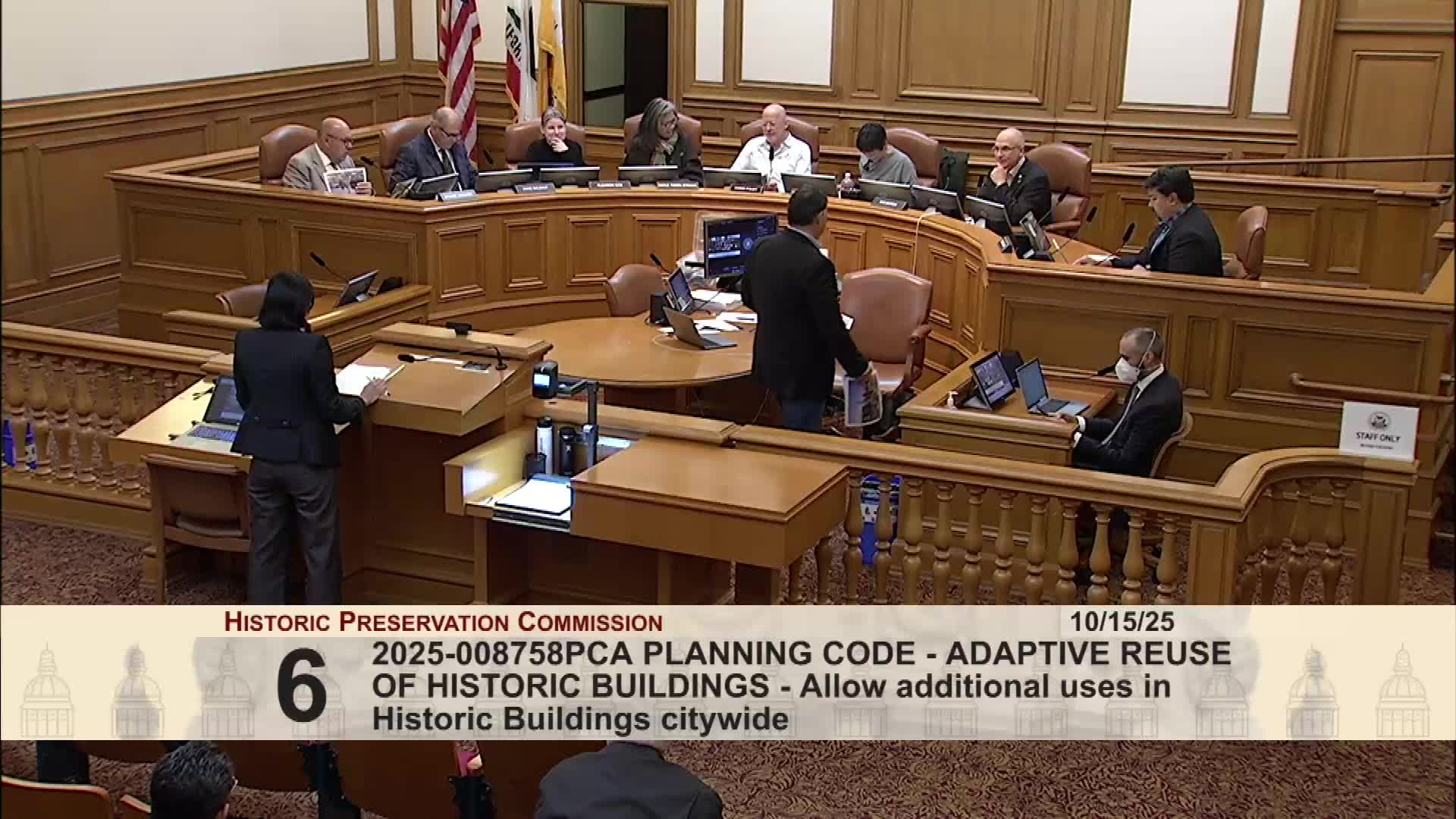Commission backs planning code amendment to expand adaptive reuse options for historic buildings
October 15, 2025 | San Francisco City, San Francisco County, California
This article was created by AI summarizing key points discussed. AI makes mistakes, so for full details and context, please refer to the video of the full meeting. Please report any errors so we can fix them. Report an error »

On Oct. 15 the San Francisco Historic Preservation Commission unanimously recommended approval of a planning code amendment titled “Adaptive Reuse of Historic Buildings,” a staff-drafted ordinance intended to standardize and expand the city’s existing use-flexibility programs for historic properties.
Planning Department staff presented the proposal, saying the ordinance would consolidate three existing programs into a single, citywide framework. Key provisions described by staff include: standardizing eligibility for all Planning Code historic resources defined in Section 102; allowing the planning director to find that a proposed use enhances the feasibility of adaptive reuse; requiring compliance with the Secretary of the Interior’s Standards for Rehabilitation; waiving some nonresidential use-size limits in specified districts; exempting certain PDR replacement requirements in Eastern Neighborhoods mixed-use districts; and allowing extended temporary uses for up to six years with a possible six-year director-approved extension.
Staff said the ordinance would retain protections in residential zones by preserving existing controls where appropriate and would permit broader principal uses in mixed-use and commercial districts. During public comment, Katie Connery, executive director of the Tenderloin Museum, supported the measure and said it would ease burdens on small nonprofits seeking to expand without undertaking costly conditional-use processes.
Commissioners asked clarifying questions about ground-floor PDR replacement rules, cannabis retail locational constraints, storefront activation standards and how the ordinance interacts with certificate-of-appropriateness review. Staff answered that PDR replacement requirements would be waived for historic buildings in the described districts, that cannabis locational rules and other regulatory limitations would still apply, and that ground-floor active-use standards would continue to be enforced where applicable.
A motion to adopt a recommendation for approval was made and seconded; the commission voted 7–0 to recommend approval to the Board of Supervisors.
Planning Department staff presented the proposal, saying the ordinance would consolidate three existing programs into a single, citywide framework. Key provisions described by staff include: standardizing eligibility for all Planning Code historic resources defined in Section 102; allowing the planning director to find that a proposed use enhances the feasibility of adaptive reuse; requiring compliance with the Secretary of the Interior’s Standards for Rehabilitation; waiving some nonresidential use-size limits in specified districts; exempting certain PDR replacement requirements in Eastern Neighborhoods mixed-use districts; and allowing extended temporary uses for up to six years with a possible six-year director-approved extension.
Staff said the ordinance would retain protections in residential zones by preserving existing controls where appropriate and would permit broader principal uses in mixed-use and commercial districts. During public comment, Katie Connery, executive director of the Tenderloin Museum, supported the measure and said it would ease burdens on small nonprofits seeking to expand without undertaking costly conditional-use processes.
Commissioners asked clarifying questions about ground-floor PDR replacement rules, cannabis retail locational constraints, storefront activation standards and how the ordinance interacts with certificate-of-appropriateness review. Staff answered that PDR replacement requirements would be waived for historic buildings in the described districts, that cannabis locational rules and other regulatory limitations would still apply, and that ground-floor active-use standards would continue to be enforced where applicable.
A motion to adopt a recommendation for approval was made and seconded; the commission voted 7–0 to recommend approval to the Board of Supervisors.
View the Full Meeting & All Its Details
This article offers just a summary. Unlock complete video, transcripts, and insights as a Founder Member.
✓
Watch full, unedited meeting videos
✓
Search every word spoken in unlimited transcripts
✓
AI summaries & real-time alerts (all government levels)
✓
Permanent access to expanding government content
30-day money-back guarantee

